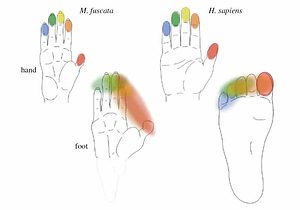
Shape of the hand and foot in two primate species. The fingers are represented independently (colour coded) in the primate somatosensory cortex (SI). By contrast, the representations of the toes are fused, with the exception of the big toe in humans. (Credit: Image courtesy of RIKEN)
A common assumption in human evolution is that our early ancestors first developed bipedal locomotion and only then did they developed dexterous hands capable of using tools, since these were free to be used no longer being required for walking. A new research by a team of Japanese scientists proved this long-standing assumption wrong, however, after they used high-end laboratory techniques to show that dexterous hands evolved before agile feet used in locomotion.
The research is particularly interesting because it combines a range of multi-disciplinary techniques and makes use of evolutionary correlations between modern humans and monkeys of today and those from the dawn of our genus. The researchers led by neurobiologist Dr. Atsushi Iriki of the RIKEN Brain Science Institute employed functional magnetic resonance imaging in humans and electrical recording from monkeys to locate the brain areas responsible for touch awareness in individual fingers and toes, called somatotopic maps. These maps showed that both humans and monkeys have discrete neural signatures for single digits in the hand and foot.
[READ MORE] Why human ancestors started walking on two legs
There’s one prominent difference between the monkey and human maps: the human big toe has its own map, while all monkey toes are combined and fused into one single map. These findings suggest that early hominids evolved dexterous fingers when they were still quadrupeds. Manual dexterity was not further expanded in monkeys, but humans gained fine finger control and a big toe to aid bipedal locomotion.
“In early quadruped hominids, finger control and tool use were feasible, while an independent adaptation involving the use of the big toe for functions like balance and walking occurred with bipedality,” the authors explained.
To support these laboratory findings, the researchers showcased the well-preserved hand and feet bones of a 4.4 million year-old skeleton of the quadruped hominid Ardipithecus ramidus, a species with hand dexterity that preceded the human-monkey lineage split. In all, the findings suggest that our early ancestors first developed hand dexterity, critical to tool use, while two-legged locomotion came after as a consequence of adaptive pressures on ancestral quadrupeds for balance control by foot digits.
“Evolution is not usually thought of as being accessible to study in the laboratory,” stated Dr. Iriki, “but our new method of using comparative brain physiology to decipher ancestral traces of adaptation may allow us to re-examine Darwin’s theories.”
The results were reported in a paper published in journal Philosophical Transactions of the Royal Society.









